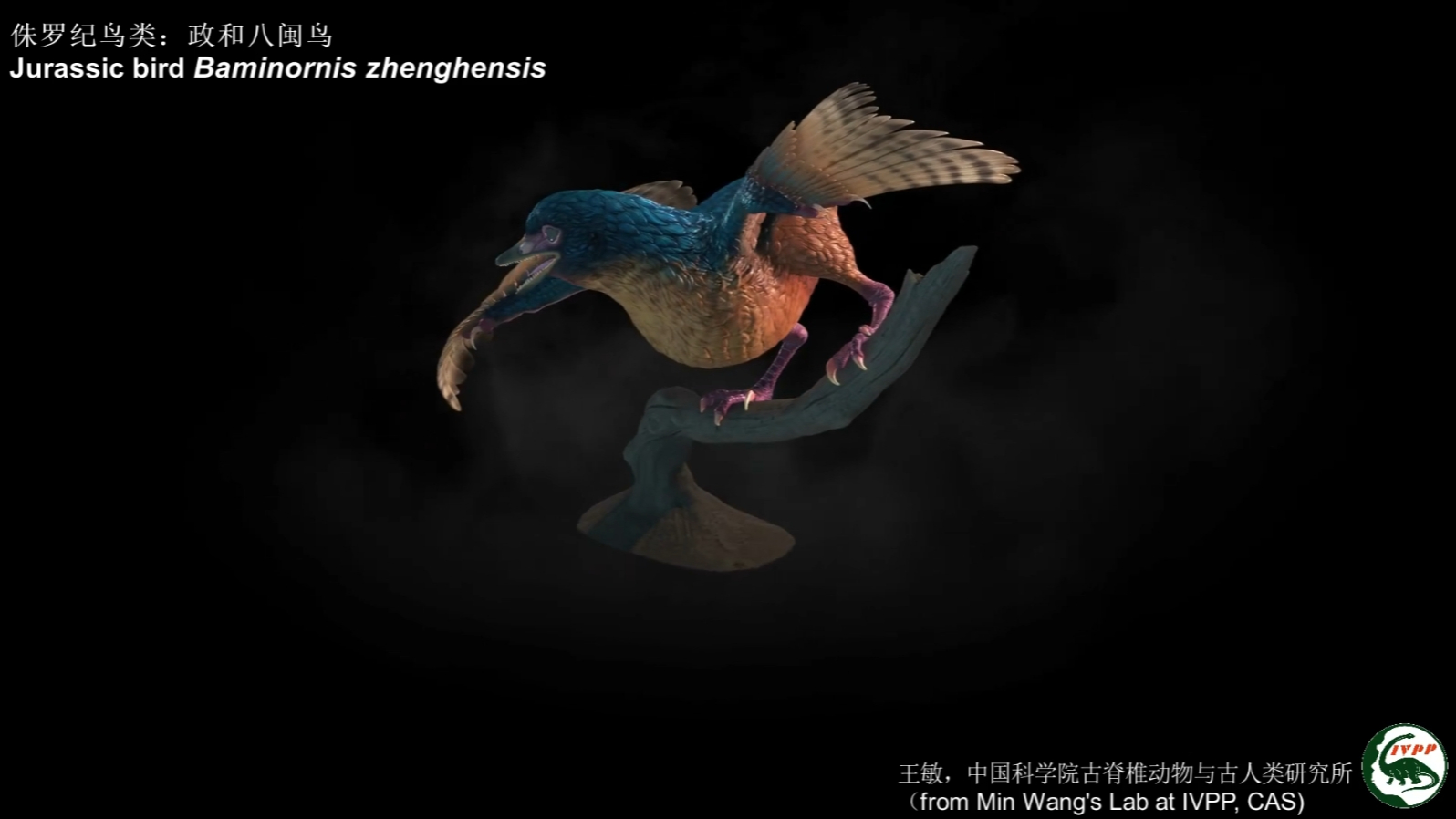

The most shocking scene in the history of life evolution is considered to be the process of dinosaurs evolving into birds, which involved a large number of changes in bones, muscles, epidermal derivatives and other biological structures.
When did the first bird appear on Earth? In other words, when did birds originate? On February 13, Chinese scientists announced the fossil of the world's earliest and oldest bird, the "Zhenghe Bamin Bird". This discovery pushed the origin of birds back to the late Middle Jurassic (172 million to 164 million years ago), confirming for the first time that the body shape of modern birds had appeared in the Jurassic, and pushed the time of this feature's appearance forward by 20 million years, rewriting the history of bird evolution.
"Bamin" is the ancient name of Fujian. Researchers believe that Zhenghe Bamin bird is the most accurate and the only Jurassic bird.
The cooperation between the institute and the local government has been going on for four years. On February 13, Wang Min's team from the Institute of Vertebrate Paleontology and Paleoanthropology, Chinese Academy of Sciences (hereinafter referred to as "IVPP") and the team from the Fujian Institute of Geological Survey (hereinafter referred to as "FGS") jointly held a press conference in Fuzhou to announce the above research progress.
The relevant research paper was published in the top international academic journal Nature on February 13, Beijing time.

Ecological restoration map of Zhenghe Bamin Birds and Zhenghe Animal Groups, drawn by Zhao Chuang
At the same time, Nature published a commentary on the research of Zhenghe Baminornis by Stephen L. Brusatte, a paleontologist at the University of Edinburgh, UK, saying that "Zhenghe Baminornis is a groundbreaking discovery and the most important bird fossil since the discovery of the Archaeopteryx fossil in 1861."
The Jurassic period is a geological period that began at the end of the Triassic period 201.3 million years ago and lasted until the Cretaceous period 145 million years ago, spanning about 60 million years.
Previously, it was believed that the oldest bird fossils were several Archaeopteryx fossils from the Jurassic period. However, some studies have suggested that Archaeopteryx belonged to the Deinonychus, not birds.

The joint expedition team of the Institute of Vertebrate Paleontology and Paleoanthropology, Chinese Academy of Sciences and Fujian Institute of Geology and Mineral Resources discovered the holotype specimen of Zhenghe Baminornis
Were there any definite birds in the Jurassic period?
The shortening of the tailbone is one of the biggest morphological changes in the evolution of dinosaurs into birds. Therefore, the most obvious difference between birds and other reptiles is that birds have very short tails. Not only are the number of caudal vertebrae reduced, but the last few caudal vertebrae are fused into a structure called the pygostyle. The appearance of the pygostyle is crucial to the forward shift of the center of gravity of birds, the independent movement of the hind limbs and the tailbone, and the improvement of flight ability.

The holotype specimen of Zhenghe Baminornis. Photo provided by Wang Min
However, "potential Jurassic birds" including Archaeopteryx and Anchiornis still have long tail bones like dinosaurs. Therefore, they are very different from birds, at least in terms of body shape.
The most special thing about the newly announced "Zhenghe Eight-Min Bird" is that it has a pygostyle structure, which is the cornerstone of the body shape of modern birds.

The evolutionary tree of Mesozoic theropod dinosaurs (including birds), and the morphological space of forelimbs, shoulder girdle and hind limbs. Image provided by Wang Min
The discovery of the Minornis confirmed for the first time that the body size of modern birds had appeared in the Jurassic period, and pushed the time of the appearance of this feature forward by 20 million years.
Since 2021, researchers Wang Min and Zhou Zhonghe have cooperated with the Fujian Institute of Geology and Mineral Resources to form a field team to carry out systematic paleontological and stratigraphic surveys in Fujian Province.
In September 2023, the joint team published a paper reporting the first discovery of dinosaur bone fossils in Fujian Province and named it "Zhenghe Fauna".
In November 2023, the field team discovered an incomplete reptile fossil in the Zhenghe fauna. Although only part of the shoulder girdle bone was exposed from the surrounding rock, Wang Min and Zhou Zhonghe thought it might be a bird fossil at first glance.

Zhenghe Zoo discovered a forkbone that is suspected to be a modern bird. Photo provided by Wang Min
After a year-long indoor restoration and research and analysis, the research team determined that the fossil belonged to a bird and named it "Baminornis zhenghensis".
In addition to the discovery of Baminornis, the research team also found a separately preserved forkbone. The results show that the forkbone is very similar to the modern birds of the Cretaceous, but is clearly different from Zhenghe Baminornis and other Jurassic birds and dinosaurs. If the forkbone does belong to the modern birds, then the origin of the modern birds will be further advanced - from the previously believed 130 million years ago to 150 million years ago.
The researchers believe that the discovery of the Minorniss and the forkbone also confirms that at least two species of birds lived in the Zhenghe fauna, and further shows the great potential of the Zhenghe fauna for exploring the evolution of East Asia's Late Mesozoic ecosystems.



Hi, Your brand deserves to stand out, and we’re here to help. At Global Wide PR, we specialize in connecting businesses with top media platforms to increase visibility and credibility. As a gesture to get started, we’re offering a free article on Digital Journal—a great way to showcase your business to a wider audience. For those looking to maximize exposure, we can also feature your brand on affiliates of FOX, NBC, CBS, ABC, and 300+ other sites for just $297. These placements can help you build trust and attract new customers. To take advantage of this opportunity, click the link below to sign up on our site, and we’ll get back to you ASAP: https://bit.ly/gwidepressrelease Looking forward to helping your brand shine! Best regards, Claudine Global Wide PR We value your preferences and understand that our emails may not always be relevant. To opt out of our emails, please submit the unsubscribe form with your website address: bit. ly/unsubscribemeurl